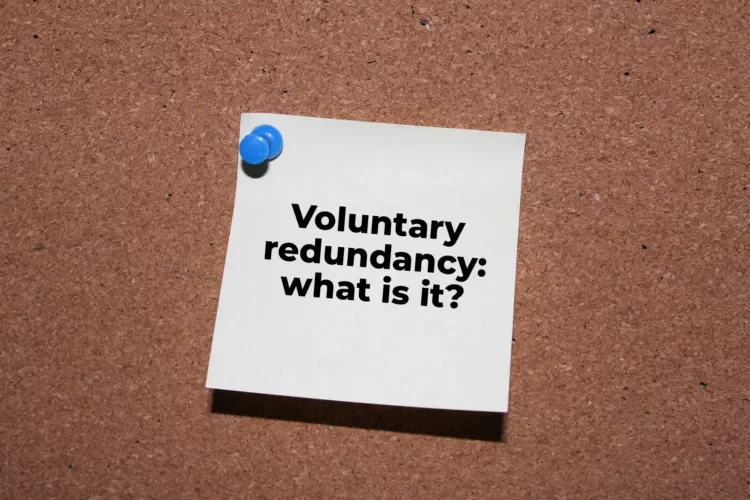Compulsory redundancy and voluntary redundancy – what’s the difference?

Before we start, it may be worthwhile asking what the difference between redundancy and dismissal is. Simply put, dismissal is a result of something that the employee has or hasn’t done. Redundancy is a result of when the employer has a reduced need for a particular type of work to be carried out.
The difference between compulsory and voluntary redundancy is that when it is compulsory, it entails a legal consultation and selection process determining the roles and employees at risk of redundancy. In contrast, the latter relies on an employee stepping forward voluntarily.
Redundancies and Restructuring
If your company needs to restructure or develop its business in a different way, you may need to evaluate the current and future requirements of job roles and skills necessary to achieve those aims. Often, such decisions will require a reduction in headcount and/or change in role or associated tasks.
Many business leaders think that compulsory redundancy is the only option. However, if the business continues to operate, it may be possible to consider whether voluntary redundancy could be offered as an alternative method of rationalising the business. Business leaders need to note that it is a job role or post that becomes redundant – redundancy is not person-specific.
Before commencing a redundancy and restructuring processes, every effort should be made to try and avoid redundancies. This could be achieved by, for example, restricting recruitment and overtime in relevant areas, early retirement and redeployment to other suitable alternative employment within the organisation. It is also essential to check the terms of the employment contract and handbook to see whether it is a contractual requirement to offer voluntary redundancy before progressing with compulsory redundancies and if any voluntary redundancy rules are in place.
“Excellent, Professional and Friendly Service”
“Fully knowledgeable, friendly, helpful and supportive throughout.” Read the full review
Voluntary redundancy
Voluntary redundancy normally offers a greater financial payment to employees; this approach is to incentivise staff to apply for voluntary redundancy. The benefit of offering voluntary redundancy is that it is more likely to create a positive work culture. Ideally, this approach allows staff that are discontented or those considering an exit from the business, to do so in a positive, dignified way.
Good reasons for voluntary redundancy
Voluntary redundancy can project a positive, caring image for the company and reduce brand damage or concern. When employees leave of their own free will, the motivation and morale of the team can remain high, if the rebalancing of roles and skills are handled in a timely and sensitive manner. Do you and your managers know what knowledge and skills are required by each job role? If not, a training and skills matrix should be created with your HR Partner. This approach allows the business to be proactive and agile, changing shape in accordance with the needs of the world and customers.
Voluntary redundancy is often more transparent; leaders do not need to create a selection process. However, understanding the knowledge and skills required to future-proof the business will assist with decision-making when agreeing or not agreeing to applications for voluntary redundancy.
The voluntary redundancy process
The first step is to communicate with eligible employees and explain the situation that the organisation is facing. Absolute clarity in this communication helps to retain trust and minimise the circulation of rumours. In this communication, the employer’s offer will be explained along with the process to be followed for those volunteering for redundancy.
For those that express an interest, a voluntary redundancy letter should be supplied confirming the terms of the voluntary redundancy package. This offer should be fair, appealing and clear regarding payments, notice period and benefits, including annual leave.
It is important to note that employees can decline the offer and withdraw from the voluntary redundancy process if they do not agree with the terms. If agreement is reached, it is key to ensure that the employee confirms this in writing. All communications and discussions should be recorded carefully in case of dispute.
Voluntary redundancy pay
Employers tend to offer a higher voluntary redundancy payout than the statutory redundancy pay, as an incentive for taking voluntary redundancy. The amount will usually take into account factors such as the employee’s age, salary and length of service.
What happens if no one volunteers to be made redundant?
In this case, the company must move into a compulsory redundancy situation.
What happens if all my best people want to be made redundant?
It is often the best people who come forward; this is because they are confident that they can find other employment. The employer will need to weigh up the skills required in the business and decide if the business is able to agree to the redundancy.
If employees ask for voluntary redundancy, do I have to agree to it?
It is not mandatory that the business agrees to a request to be made redundant; however, clear communication as to why an application is declined or accepted is crucial, especially when trying to keep the employee and other staff motivated and engaged. Maintaining a record of decisions made is important and this will ensure that an audit trail is created which could be referred to if legal advice is required in relation to an employment tribunal claim.
Usually, senior or long-term employees are offered the opportunity for voluntary redundancy, although it is possible for other employees to apply if they want to be considered.
The pros and cons of taking voluntary redundancy
From an employee perspective, voluntary redundancy could be a good opportunity to step away with better financial terms than a statutory redundancy package, particularly if they were already considering leaving or they are confident of finding a new role.
However, it may affect an employee’s ability to claim payment protection if voluntary redundancy is not covered by their policy. If it takes longer than expected to find a new role, then they may face financial hardship.
If some of your workforce are approaching retirement, they may be interested in applying for voluntary redundancy. However, it is important to beware of falling foul of age discrimination since there is no compulsory retirement age and employers should not make assumptions about how long an employee may wish to continue working.
Compulsory redundancy
Compulsory redundancy may be necessary once all avenues to avoid job losses have been explored. To mitigate the risk of an unfair dismissal claim, a fair redundancy process must be followed including appropriate selection criteria, before selecting employees for redundancy.
Making employees redundant
Leaders must consult with staff and employee representatives (where applicable) to identify the roles at risk. The duration of the consultation process will depend on the situation’s complexity and the number of roles affected.
The process will include communicating the business reasons for the redundancy, sharing the selection criteria/matrix (if applicable) to be used to select those being made redundant and time scales.
Engaging empathetically with staff who are directly affected and supporting them step by step through the process is key to managing risk from an employment law and reputational perspective. Attention should also be given to the remaining employees to support them through the period of change and assist them in their new roles and responsibilities.
Statutory redundancy pay
The statutory payment due if an employee is selected for redundancy is established via a calculation set by the UK Government. To qualify for redundancy, employees need to have been continuously employed for at least two years. The calculation is based on length of service, age and average weekly pay.
Statutory redundancy pay is calculated as follows:
- half a week’s pay for each full year you were under 22
- one week’s pay for each full year you were 22 or older, but under 41
- one and half week’s pay for each full year you were 41 or older
Weekly pay is calculated based on an average the employee earned per week over the 12 weeks before the day they got their redundancy notice. Length of service is capped at 20 years.
For redundancies on or after 6 April 2023, weekly pay is capped at £643 and the maximum statutory redundancy pay an employee can get is £19,290.
To find out more about the process and cost of redundancy, contact a member of the MAD-HR team, who will work with you to evaluate the risks associated with a voluntary vs compulsory redundancy approach and support you every step of the way.
Frequently Asked Questions
Useful questions and answers about “Compulsory redundancy and voluntary redundancy – what’s the difference?”
What is voluntary redundancy?
Voluntary redundancy allows employees to leave their role in exchange for an exit package which is usually accompanied by a legal agreement. It is often used as an alternative to compulsory redundancy during organisation restructures.
What is compulsory redundancy?
This happens when an employee's contract is terminated by reason of redundancy
This happens when an employee's contract is terminated by reason of redundancy
In the UK, generally redundancy payments will be tax free to a maximum threshold outlined by HMRC. It is advisable to seek professional guidance based on the individual circumstances of the voluntary redundancy package.
The content of this article is for general information only. It is not, and should not be taken as, legal advice. If you require any further information in relation to this article please contact us.
There may be occasions where the articles contain links to external websites. We have no control over the nature, content and availability of those sites. The inclusion of such links does imply a recommendation or endorse the views expressed within them.



